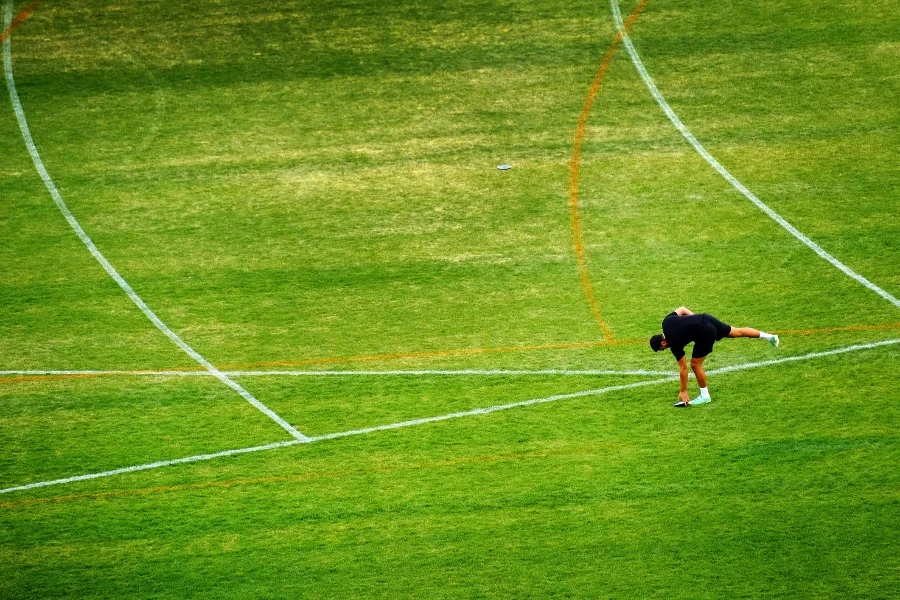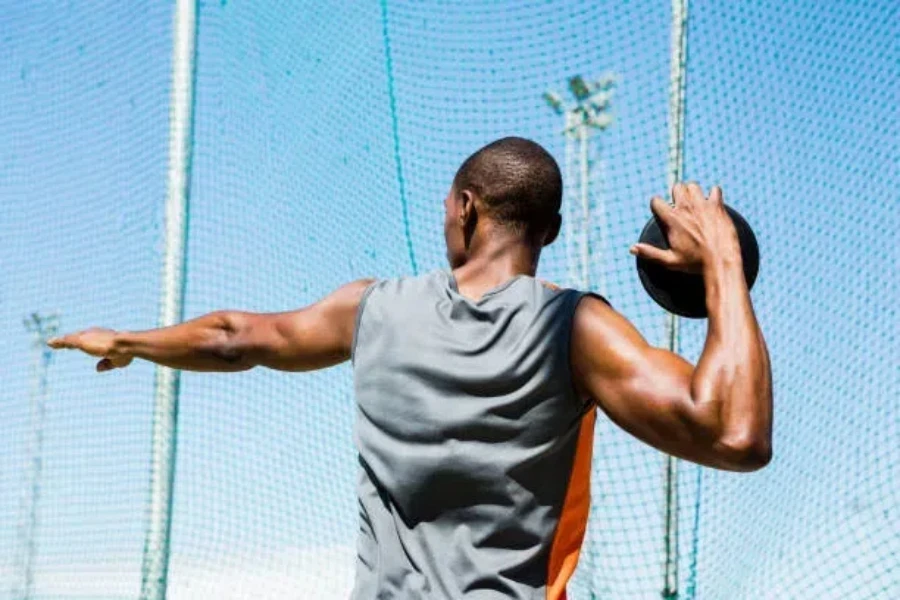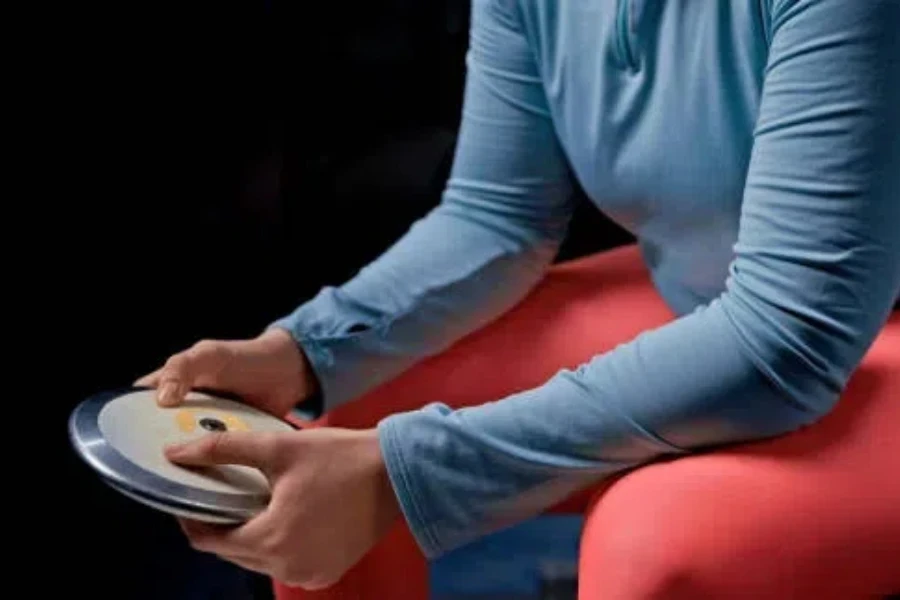Discus throw is an ancient sport that’s still very popular today in track and field events. Selecting the right discus is a crucial step for athletes who aim to perform well at competitive events. Although the discus is a very simple piece of equipment, athletes still need to consider factors such as the weight, material, and size.
This guide will cover what the most popular discus types, as well as the skill level and goals that best match each one. Keep reading to learn more about discus and what consumers are looking for within the market.
Table of Contents
What is discus?
Is discus popular?
Global market value of track and field equipment
Important discus features
Conclusion
What is discus?

The discus is a circular, flat object that’s thrown in track and field events. It can be made of different materials, such as wood or metal, and has varying weights and sizes depending on the athlete using it.
During the discus throw, athletes will build momentum by spinning in an outlined circle before launching the discus as far as possible. It’s a unique sport that combines precision, strength, and technique, so choosing the correct discus is very important for the athlete.
Is discus popular?
Like other track and field events such as shot put and javelin, discus is only growing in popularity among consumers. This is down to a number of factors, such as track and field being shown more on streaming platforms, and the regular occurrence of the Olympics, which are watched throughout the world.
According to Google Ads, “discus” has an average monthly search volume of 201,000. Compared to other track and field sports, discus maintains a steady search rate throughout the year, with only January, July, and August seeing a slight drop in searches, down to 165,00 per month. These figures show just how popular discus is and how versatile it is as a track and field competition.
Global market value of track and field equipment

The popularity of track and field events has grown significantly over the past decade. New advancements in technology as well as changing customer preferences have forced market players to quickly adapt and find solutions for sustainable growth. The market is seeing a steady increase in the number of online sales, which allows consumers to gain access to track and field equipment in a more timely manner.
By 2031, the track and field equipment market is projected to be valued at USD 161.67 billion. This is a rapid increase from the USD 101 billion in 2023. The compound annual growth rate (CAGR) between 2024 and 2031 is expected to sit at 6.69%.
Important discus features

The discus is a fairly simple piece of track and field equipment to use, but it takes a lot of time and skill to master the throwing technique. There are several key features that athletes need to consider when they’re choosing the right discus, as not all discuses are designed the same.
Material
One of the biggest considerations to take into account when choosing a discus is the material. It can play a crucial role in the athlete’s performance, and each material has its own features.
Composite discuses are made from materials such as carbon fiber or fiberglass and offer athletes a good blend of lightweight properties and strength. They’re considered high-performance discuses and are designed to achieve optimal flight characteristics, making them suitable for competitions.
Wooden discuses are very lightweight and are generally used for training at the beginner stage since they’re easy to use and very affordable.
Finally, metal discuses are more durable than composite and wooden discuses, being made of brass or steel. Metal is the preferred material for intermediate and professional athletes who need to maintain a consistent performance.
Each material offers competitors something different, which will have a direct impact on the distance and flight stability. Athletes will choose a discus that’s right for them based on their skill level.

Size and weight
To ensure fair competition, the size and weight of discuses are standardized according to the gender and age of the athlete. A discus that’s too heavy or too large for an athlete can seriously hinder their technique and lead to injury. In order to maximize performance potential, choosing the right size and weight is essential.
For men’s discus competitions, the discus weighs 2 kilograms and has a diameter of approximately 22 centimeters. For women discus throwers, the weight comes down to 1 kilogram and is around 18 centimeters in diameter. Young athletes will have discus weights as low as 0.75 kilograms depending on their age category.

Rim weight percentage
The overall size and weight of the discus is very important, but the rim weight percentage is just as important to look into. This refers to the total weight of the discus that’s concentrated in the outer rim, which has a direct effect on stability and flight characteristics.
Having a rim with a higher weight percentage, between 70% and 85%, will enhance the aerodynamic stability and enable the discus to travel further because more weight is distributed toward the edge. This type of discus requires a higher level of strength and skill to throw effectively since it’s more challenging to control.
Discuses that have a weight percentage under 70% are easier to throw and more suited to beginners or young athletes. They’re more forgiving if the technique isn’t perfect, which makes them ideal for training. As discus throwers progress, they will eventually transition to a discus that has a higher rim weight.
Skill level
One of the biggest factors when choosing the right discus is the skill level of the athlete. Not all discuses are built for the same purpose, so buyers need to be made aware of how choosing the wrong one can negatively affect their performance.
Beginners should start with a lower rim weight percentage while they’re still learning the basic techniques. This allows them to better control the discus and work on their overall form while also focusing on building strength. Training with this type of discus allows the athlete to work on proper mechanics and build confidence before moving onto a heavier discus. They’ll typically use wooden or lower-end composite discuses to start with.
Athletes who are more advanced will use a higher rim weight percentage, which is designed for better aerodynamic performance and greater distance. The discus will be made of high-quality materials such as metal or advanced composites for durability and performance purposes. These discuses require more power and precision to throw, so they’re only suitable for athletes who are working on fine-tuning their performance and who are competing at high-level competitions.
Conclusion
When choosing the right discus for training and competitions, athletes will look at factors such as the material, the weight and size, the rim weight percentage, and their own skill levels. Like many track and field events, discus is projected to grow in popularity over the next several years, which means the industry will need to look at incorporating new technologies into the latest discuses.




